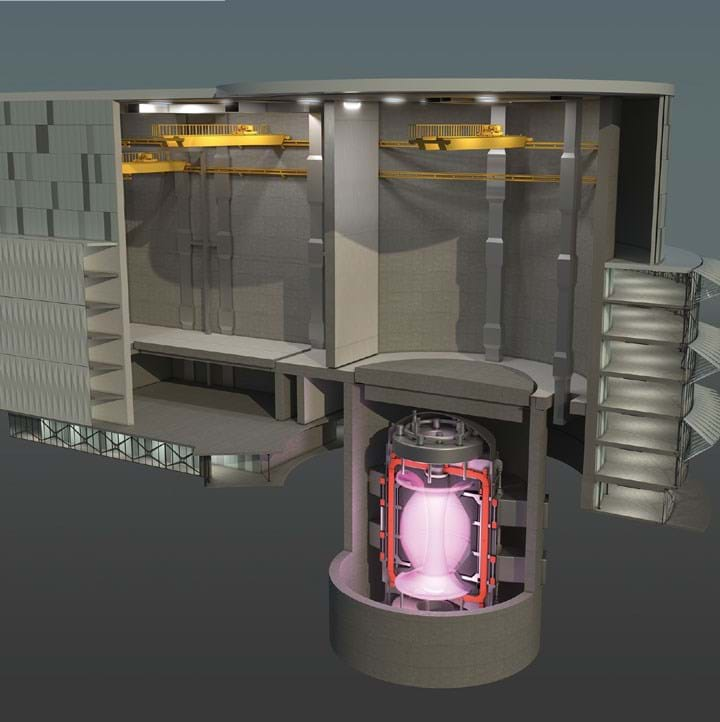UK picks Midlands to host prototype fusion reactor

THE site of a coal-fired power plant in Nottinghamshire is set to host the UK’s prototype nuclear fusion energy plant.
The UK Government has selected the West Burton power station site to host the demonstrator, known as the Spherical Tokamak for Energy Production (STEP) plant. The goal of the plant is to put net electricity on the grid in the 2040s and pave the way for commercialising fusion power.
Nuclear fusion involves forcing together nuclei – mimicking the processes that drive the Sun – and harnessing the energy that is released. The potential benefits are huge. The technology would produce carbon-free, baseload power without creating the long-lived radioactive waste that comes out of conventional fission plants. Yet there are significant technological hurdles that scientists and engineers must overcome to demonstrate fusion is viable. Fusion experiments have not yet managed to produce net energy – they have required more energy be put in to fuse nuclei than has been produced.
A concept design for STEP is expected by 2024, which will provide an outline the plant and how the UKAEA will design each of the major systems. The authority wants to design a more compact plant than other fusion energy programmes in order to reduce costs, and use a spherical-shaped reactor rather than a ring donut shaped reactor that is being favoured in other designs. It expects this will help improve the efficiency of the magnetic fields used to confine the plasma fusion fuel.

Ian Chapman, CEO of the UK Atomic Energy Authority, said: “Selecting the location of the STEP prototype plant is a huge, visible moment in the challenging and long-term endeavour of bringing fusion energy to the grid. West Burton is a natural fit for the STEP programme with a rich industrial heritage now being developed and repurposed for a low carbon future. It really is ‘from fossil fuels to fusion’”.
The UK Government said it expects the STEP programme will create thousands of highly skilled jobs during construction and operations and attract other high-tech industries to the region. It says conversations are underway with local employers about the development of apprenticeship schemes.
John Peace, Chairman of Midlands Engine, a partnership of local interests that supported the bid to host the site, said: “The Midlands Engine partnership welcomes the Government and UKAEA’s decision to choose West Burton as the site for its STEP fusion prototype. In an area which has long suffered from underinvestment, the site stands to play a crucial role in boosting local and regional economic activity, job creation and productivity. The project is more than a power station – it will require an ecosystem of innovation and development and will become a global focus for fusion power.
Martin Freer, Director of the Energy Research Accelerator (ERA), a consortium of universities in the Midlands, said: “Fusion has the potential to be transformative for the way we produce energy here in the UK. It could provide an almost limitless supply of safe, clean electricity and help with the toughest decarbonisation challenges by using heat to manufacture hydrogen and synthetic clean fuels – other areas where our region and ERA have expertise. We look forward to building on our work with the UKAEA, bringing the region’s first-class skills and innovation capabilities to bear on this exciting project.”
Last year, the UK Government released a fusion strategy setting out its goals to successfully demonstrate the technology and build a world-leading fusion industry. Earlier this year, fusion researchers in the UK achieved a record-breaking sustained boost of energy that was hailed as the clearest indication in a quarter of a century that the technology can produce abundant low-carbon energy. The UKAEA also signed an agreement with Common Fusion Systems (CFS) of the US to speed up commercialisation of nuclear fusion power, which includes sharing lessons from fusion experiments and working together on fuel cycle technologies, systems integration models, and advanced manufacturing. Despite the promise of the technology to usher in a clean energy future, it will not be developed quickly enough to reduce emissions in time to meet mid-century climate goals.
The UK Government is providing £220m (US$244m) in funding for the first phase of STEP. The other sites that were shortlisted for STEP include Ardeer in North Ayrshire, Moorside in Cumbria, Goole in East Yorkshire, and Severn Edge in Gloucestershire.
Recent Editions
Catch up on the latest news, views and jobs from The Chemical Engineer. Below are the four latest issues. View a wider selection of the archive from within the Magazine section of this site.




